THE GREAT RACES, PART XVII.
 Sunday, May 14, 2023 at 09:00AM
Sunday, May 14, 2023 at 09:00AM Detroit. The sport of motor racing is filled with memorable races marked by both triumph and tragedy. It's the nature of the sport that these two extremes have left such an indelible impression that they live on for decades, leaving a legacy that is part and parcel of our collective memories. The many heroic individuals - and individual efforts - that have carved out their place in motorsport history are too often luridly offset by gut-wrenching tragedies that have torn us apart along the way. It is an unfortunate consequence of a sport that consumes everything and everyone in its path, a fevered, relentless pursuit marked by unbridled elation and devastating, soul-crushing disappointment. In this series I will try to avoid dwelling on the tragic stories, because as enthusiasts of this sport we are all too familiar with them. If, in the course of talking about a particular race mentioning a tragic event is unavoidable that will have to be, but this series will mainly focus on those memorable moments from those glory days that rivet us to this day. This week, we take a look back at the 1966 ADAC Nurburgring 1000 Kilometers, Round 6 of the World Sportscar Championship.
 (Getty Images)
(Getty Images)The Nurburgring, June 5, 1966. The Phil Hill/Jo Bonnier No. 7 Chaparral 2D Chevrolet at speed on the Nurburgring Nordschleife. Jim Hall's Chaparral Cars team was competing against factory-supported teams from Ford, Ferrari and Porsche that day. It was an impressive list of cars and drivers, including: John Surtees/Mike Parkes (No. 1 Ferrari 330 P3); Surtees and Parkes were also listed as drivers of the No. 2 Ferrari P3 along with Lorenzo Bandini; Jochen Rindt/Nino Vaccarella (No. 5 Porsche 906-8); Ludovico Scarfiotti and Bandini (again) would be in the No. 11 Ferrari Dino 206 S; Pedro Rodriguez/Richie Ginther (No. 12 Ferrari Dino 206 S); Richard Attwood/David Piper (No. 14 Ferrari Dino 206 S); Hans Herrmann/Dieter Glemser (No. 15 Porsche 906 E); Bob Bondurant/Paul Hawkins (No. 17 Porsche 906 E); Jo Siffert/Charles Vogele (No. 18 Porsche 906); Innes ireland/Mike Salmon (No. 44 Ford GT40); Jo Schlesser/Guy Ligier (No. 45 Ford GT40); Peter Revson/Skip Scott (No. 46 Ford GT40); John Whitmore/Jochen Neerpasch (No. 47 Ford GT40); Mike Spence/Richard Bond (No. 49 Ford GT40) and Peter Sutcliffe/John M. Taylor (No. 50 Ford GT40). Add to this mix a long list of assorted Cobras, Porsches, Alfa Romeos, Ferraris and Jaguars, and there was a full field - 109 entries - ready to take the green flag.

John Surtees in the No 1 Ferrari 330 P3 that he shared with Mike Parkes.

Mike Parkes in the No. 1 Ferrari 330 P during practice for the Nurburgring 1000 Kilometers.

Lorenzo Bandini in the No. 11 Ferrari 206 S that he shared with Ludovico Scarfiotti during practice for the Nurburgring 1000 Kilometers.

This excellent shot of the No. 7 Chaparral 2D Chevrolet of Phil Hill/Jo Bonnier shows the remarkable nature of the Nurburgring Nordschleife, which was the quintessential definition of a "natural terrain" road racing circuit. No barriers, no curbs, no nothin'. Just stand on the gas and hope it all works out.

Phil Hill hammers the No. 7 Chaparral 2D Chevrolet through the Karoussel at the Nurburgring Nordschleife in 1966.

The opposite view of the No. 7 Chaparral 2D Chevrolet bending into the Karoussel at the Nurburgring Nordschleife in 1966. Jim Hall always put Texas license plates on his cars when they competed in Europe.

Jo Bonnier in the beautiful Chaparral 2D Chevrolet.

The Chaparral 2D Chevrolet in the pit lane, Nurburgring, 1966. That is famed motorsports journalist Denis Jenkinson in the background.

Phil Hill and Jo Bonnier celebrate after their huge win in the 1966 Nurburgring 1000 Kilometers. It was a great day for Jim Hall's Midland, Texas-based Chaparral Cars team, and it was the second major international win for the team after their victory in the 12 Hours of Sebring in 1965. Hill/Bonnier won by just 41 seconds after 1000 Kilometers! Ludovico Scarfiotti/Lorenzo Bandini (No. 11 Ferrari Dino 206 S) finished second, Pedro Rodriguez/Richie Ginther (No. 12 Ferrari Dino 206 S), third, Bob Bondurant/Paul Hawkins (No. 17 Porsche 906 E), fourth, Jo Schlesser/Guy Ligier (No. 45 Ford GT40), fifth and Peter Sutcliffe/John M. Taylor (No. 50 Ford GT40), sixth.

Jim Hall had an extensive and all-encompassing R&D arrangement with GM Styling and Chevrolet Engineering; which had the two entities being directly involved in designing, engineering and testing Chaparral concepts. Just one example of this deep relationship was the fact that the front bodywork for the Chaparral 2, 2C and 2D was directly "lifted" from the 1962 Corvair Monza GT and SS concepts. The Chaparral 2D was completely designed by famed GM designer, Larry Shinoda, as these sketches indicate.

 The front ends of the 1962 Corvair Monza GT and Monza SS concepts were directly applied to Jim Hall's Chaparrals.
The front ends of the 1962 Corvair Monza GT and Monza SS concepts were directly applied to Jim Hall's Chaparrals.

Editor's Note: You can access previous issues of AE by clicking on "Next 1 Entries" below. - WG




